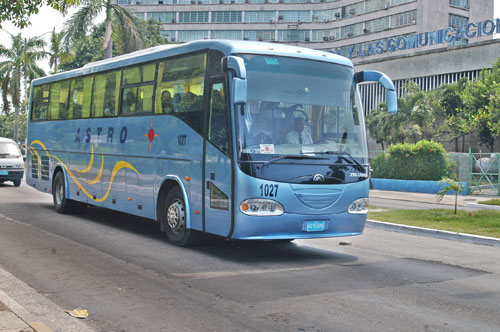Cuba’s Dirty Buses
Haroldo Dilla Alfonso

HAVANA TIMES — Ever since leaving Cuba I’ve been able to do something I couldn’t do there: read Granma, Cuba’s major, official newspaper. I read it every day – and carefully – for Granma, though terribly boring, is part of a reality that is painstakingly changing.
As a result of these changes, one can come across curious articles these days, not because the newspaper has any interest in intriguing its readers (Granma continues to insist on being a serious publication with firm ideas), but because Cuban journalists are now pretty much obliged to write pieces seasoned with some of the slogans of the day, to engage in superficial but pertinent criticism and, finally, to show off a bit of investigative skill.
The confluence of these different aims gives rise to articles that sometimes prompt questions and the occasional smile.
A few days ago, I came across an article about inter-provincial bus trips and some things that happen. The thread of the argument was nothing other than the monstrous behavior shown by a passenger who vomited into the back-pocket of the seat in front of him during a trip from the province of Las Tunas to another part of the country.
The drivers were rather upset following their discovery the day after the terrorist action, through smell alone – something which reveals the bus hadn’t been properly cleaned after a 12-hour journey and its overnight stay at its destination, and that the pockets where regular, non-vomiting passengers tend to leave their garbage, hadn’t been emptied.
Since Cuba is immersed in a campaign to rescue what its General/President conceives as the traditional good manners of Cubans, the journalist obviously thought it opportune to focus the article on this incident.
Fast and furious, she charged against unscrupulous passengers who don’t know how to behave during an inter-provincial bus trip, adding that eating on the bus isn’t allowed (even though, during the long hours on the road, buses tend to stop at places where there is no food or food that is too rich for people’s pockets).
“Often,” the journalist writes, quoting a bus driver, “passengers leave behind bits of food on the floor, bread crumbs, plastic wrappers and empty cans. They leave grease or liquid stains on the seats, and some people even wipe their hands on the curtains or the seat cover where people rest their heads during the trip.”
 That is to say, the journalist thinks it unacceptable that people should do what they do anywhere in the world during a long bus journey: eating, leaving bread crumbs and bits of food on the floor, throwing out cans and bottles and wiping their hands with whatever is available when no napkins are available.
That is to say, the journalist thinks it unacceptable that people should do what they do anywhere in the world during a long bus journey: eating, leaving bread crumbs and bits of food on the floor, throwing out cans and bottles and wiping their hands with whatever is available when no napkins are available.
As all bus companies know this, the vehicles are cleaned after every trip: disinfectants and air-fresheners are used and the remnants of human activity (including the occasional bit of vomit) are disposed of. Every so often, seat covers are removed and washed. None of this, it seems, is done in Cuba.
The journalist, however, did not seem particularly put off by things that do constitute major irregularities, mentioning these in passing at the beginning of her curious article. I quote: “(…) shady processes to be able to purchase tickets (particularly through the waiting list, in Havana), the failure of drivers to declare the real capacity of the buses at the terminals, charging fares without handing out tickets, needless stops, lunches and dinners at non-State establishments with prices that not all passengers can afford (…)” All of this makes the passenger’s vomiting incident appear like an annoying little joke.
It is a shame the journalist – surely a capable and intelligent person – was unable to offer us a more thorough analysis of what is, at root, a very complex issue. Everyone knows Cuba’s inter-provincial transportation system has long been a defective and highly corrupt enterprise, and that its chronic dysfunctionality has produced a rather common type of Cuban who has never been able to get to know the island or to enjoy more than the occasional trip.
Today, the island of Cuba is a kind of agglomeration of feudal regions populated by strictly territorialized inhabitants.
Back in the days of “real socialism”, an interprovincial journey during a peak season meant enduring an extenuating waiting list that only the most persevering of the lot were able to withstand, or those who, having the right connections and the money, were able to avoid.
When the market opened up, fare prices were such that one had to work many days, or use a remittance from Miami, to be able to travel. Today, for instance, the cheapest – and least comfortable – option for traveling to Santiago de Cuba costs almost a full, average monthly salary.
It’s expensive, just too expensive, but at least if they would clean the buses…






There is an unusual practice in Cuba where would-be passengers stand alongside the road leading out of the smaller towns waving money. If the driver has room (and sometimes when he doesn’t) he pulls over, the non-ticketed passenger boards and the driver pockets the money. It helps to be a pretty girl or a mom with small children to catch a ride this way. It also costs more if you are a foreigner.